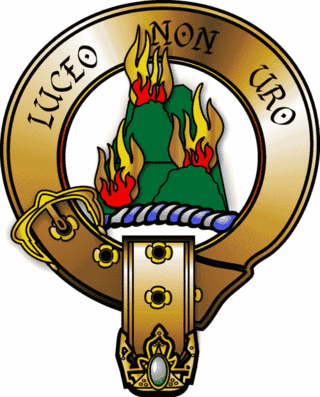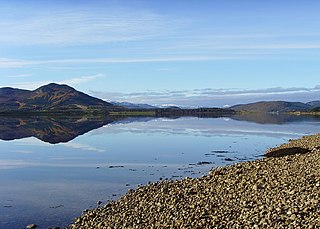
Clan Mackenzie is a Scottish clan, traditionally associated with Kintail and lands in Ross-shire in the Scottish Highlands. Traditional genealogies trace the ancestors of the Mackenzie chiefs to the 12th century. However, the earliest Mackenzie chief recorded by contemporary evidence is Alexander Mackenzie of Kintail who died some time after 1471. Traditionally, during the Wars of Scottish Independence, the Mackenzies supported Robert the Bruce, but feuded with the Earls of Ross in the latter part of the 14th century. During the 15th and 16th-centuries the Mackenzies feuded with the neighboring clans of Munro and MacDonald. In the 17th century the Mackenzie chief was made Earl of Seaforth in the peerage of Scotland. During the Scottish Civil War of the 17th century the Mackenzies largely supported the Royalists. During the Jacobite rising of 1715 the chief and clan of Mackenzie supported the Jacobite cause. However, during the Jacobite rising of 1745 the clan was divided with the chief, Kenneth Mackenzie, Lord Fortrose, supporting the British-Hanoverian Government and his relative, George Mackenzie, 3rd Earl of Cromartie, supporting the Jacobites.

Sir Robert Munro, 6th Baronet was a Scottish military officer and politician whose life followed an 18th-century pattern. He fought in support of the Revolution Settlement and the House of Hanover, and their opposition to all attempts by the Jacobites to restore the House of Stuart either by force of arms or by political intrigue. He was killed at the Battle of Falkirk Muir in 1746.

Sir Harry Munro, 7th Baronet was 25th Baron and the 28th chief of the Clan Munro. He was a Scottish soldier and politician. He was loyal to the Hanoverian dynasty and served as a captain in Loudon's Highlanders Regiment 1745–48.

The Battle of Inverurie was fought on 23 December 1745 at Inverurie, Aberdeenshire, Scotland, during the Jacobite rising of 1745.
Sir Robert Munro, 5th Baronet of Foulis was also 23rd Baron and 26th chief of the Clan Munro. He became blind and was known as the Blind Baron.
Loudon's Highlanders, or the 64th Highlanders, or Earl of Loudon's Regiment of Foot, was an infantry regiment of the British Army.

The Battle of Achnashellach was a Scottish clan battle said to have taken place in the year 1505, in the Scottish Highlands at Achnashellach. It was fought by the Clan Cameron against the Clan Mackay and the Clan Munro.

The Battle of Littleferry took place during the Jacobite rising in 1746, just before the Battle of Culloden. Scottish forces loyal to the British-Hanoverian Government defeated a Scottish Jacobite force.

Clan Munro is a Highland Scottish clan. Historically the clan was based in Easter Ross in the Scottish Highlands. Traditional origins of the clan give its founder as Donald Munro who came from the north of Ireland and settled in Scotland in the eleventh century, though its true founder may have lived much later. It is also a strong tradition that the Munro chiefs supported Robert the Bruce during the Wars of Scottish Independence. The first proven clan chief on record however is Robert de Munro who died in 1369; his father is mentioned but not named in a number of charters. The clan chiefs originally held land principally at Findon on the Black Isle but exchanged it in 1350 for Estirfowlys. Robert's son Hugh who died in 1425 was the first of the family to be styled "of Foulis", despite which clan genealogies describe him as 9th baron.

The Skirmish of Alness was a conflict that took place in October 1715 in Alness, in the county of Ross in the Scottish Highlands. It was part of the Jacobite rising of 1715 and pitted Highlanders loyal to the British-Hanoverian Government of George I of Great Britain against Highlanders loyal to the Jacobite House of Stuart.

The Skirmish of Tongue was a battle that took place in March 1746 near Tongue in the Scottish Highlands during the Jacobite Rising of 1745.
The Independent Highland Companies were irregular militia raised from the Scottish clans of the Scottish Highlands by order of the Scottish government between 1603 and 1760 in order to help keep the peace and enforce the law in the Highlands and were recognized as such by the government. The officers of the Independent Highland Companies were commissioned as officers of the British Army but the independent companies were not recognized as official regiments of the line of the army. The Independent Highland Companies were the progenitors of the Highland Regiments of the British Army that began when ten Independent Highland Companies were embodied to form the Earl of Crawford's Highland Regiment that was numbered the 43rd Regiment of Foot in 1739.
George Mackay of Skibo was a Scottish lawyer, soldier and politician. He fought for the British Government during the Jacobite rising of 1745 and was later a Member of Parliament.
The Munros of Culcairn were a minor noble Scottish family and a branch of the ancient Clan Munro, a Scottish clan of the Scottish Highlands. Their seat was at Culcairn which is on the east side of Allt Graad/River Glass in the parish of Kiltearn.
The Munros of Culrain were a minor noble Scottish family and a cadet branch of the ancient Clan Munro, a Scottish clan of the Scottish Highlands. They were seated at Culrain which is in the south of the county of Sutherland, but to the north of the main Munro clan lands in Kiltearn, Easter Ross.

The Battle of Dornoch took place on 20 March 1746 and was part of the Jacobite rising of 1745 in Scotland. However, although recorded in history as a "battle" there was no actual fighting between the two sides. Instead a large rebel Jacobite force advanced on a position held by a force loyal to the British-Hanoverian Government who were taken by surprise and forced into a retreat. The Jacobite advance was coordinated by James Drummond, 3rd Duke of Perth at Dornoch, Sutherland.

The Raids on Lochaber and Shiramore took place in the Scottish Highlands between 22 May and 31 August 1746 and were part of the closing operations of the British-Hanoverian Government to bring to an end the Jacobite rising of 1745. Sometimes referred to as the "mopping up" operations, many rebels surrendered themselves and their arms, while others were captured and punished. It also included the hunt for the Jacobite leader Bonnie Prince Charles Edward Stuart otherwise known as the Young Pretender. Most of the work was done on behalf of the Government by the Independent Highland Companies of militia, the Campbell of Argyll Militia and also Loudon's Highlanders regiment.
Hugh Mackay of Bighouse was a Scottish noble, soldier and a member of the Clan Mackay, a Scottish clan of the Scottish Highlands.
George Mackay, 3rd Lord Reay (1678–1748), was a Scottish noble and chief of the Clan Mackay, a Scottish clan of the Scottish Highlands. During his life the Glorious Revolution took place which directly affected his family and estate, and during his chiefdom he served the British-Hanoverian Government during the Jacobite rising of 1715 and the Jacobite rising of 1745.

The siege of Culloden House took place on the night of 15/16 October 1745 and was part of the Jacobite rising of 1745. 200 men of the Jacobite Clan Fraser of Lovat attempted to capture Duncan Forbes, Lord Culloden who was the Lord President of the Court of Session, the most senior legal officer in Scotland.












